MAKO SROM1269 1400W Electric Lawn Mower Instruction
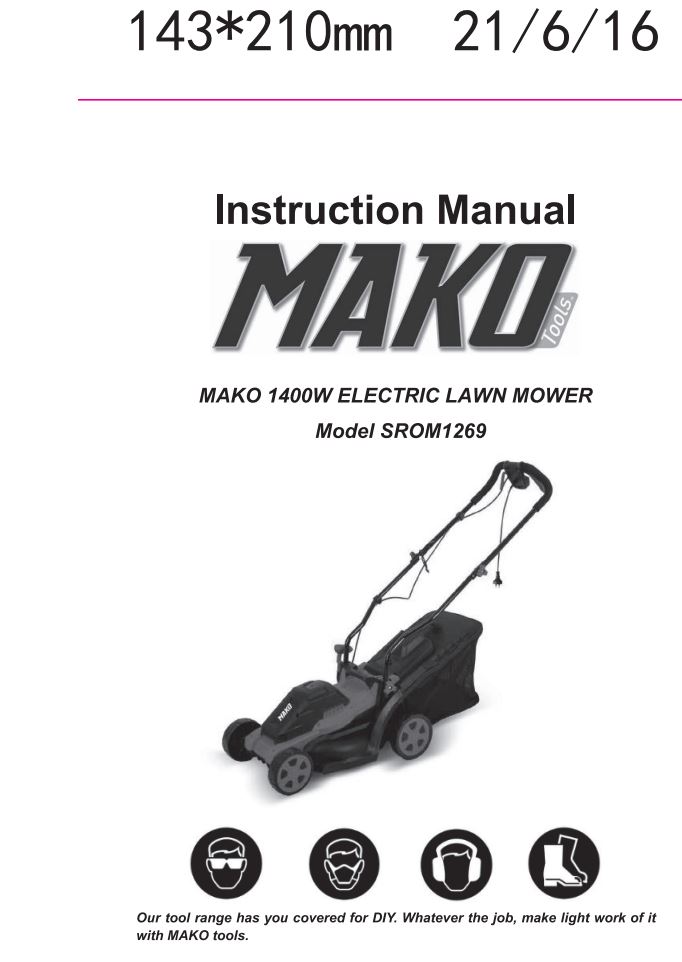
Product Features:
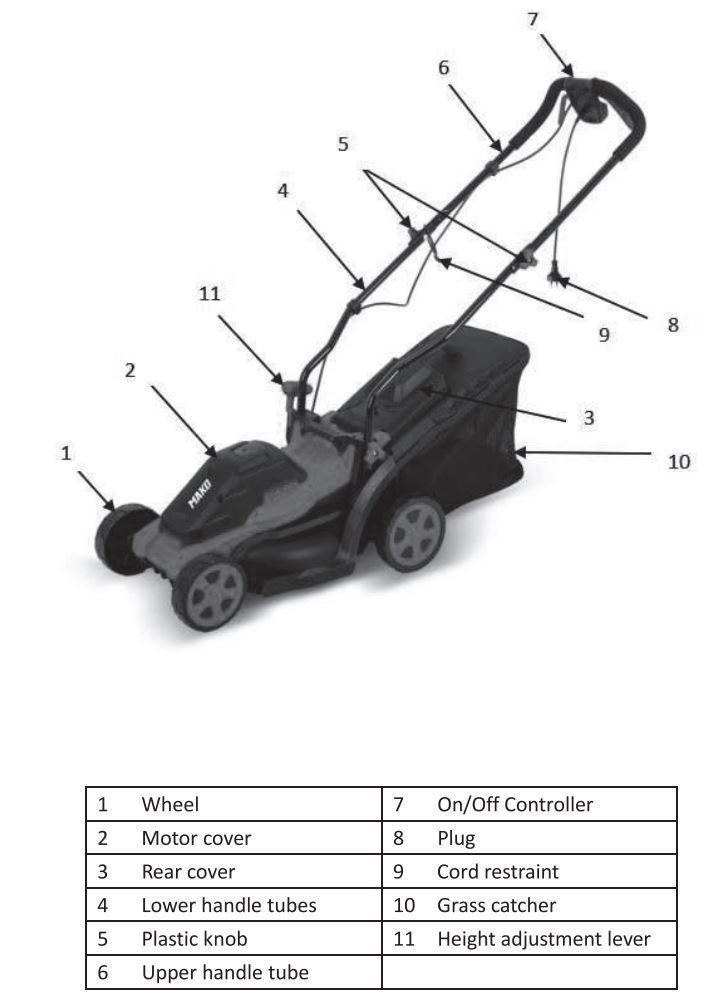 Dear Valued Customer,
Dear Valued Customer,
Thank you for purchasing this Mako Power Tool.
We are dedicated to providing quality Mako Power Tools at competitive prices. Whether you are serious about DIY or just a casual user, our range of power tools are perfect for any job.
Mako 2 Year DIY Warranty:
All Mako Power Tools are backed by a comprehensive 2 year DIY warranty. If for any reason you experience a fault with this power tool, please contact the retailer that it was purchased from, present the receipt and warranty card (al the back of the operating manual), for a full refund or replacement. The warranty is void if damage is not attributable to normal wear and tear, if the tool is used commercially, the motor is overloaded or is tampered with, is damaged by accident or if ii is bought second hand. Continued use after partial failure, or the use with the incorrect accessories will void the warranty.
MAKO TOOLS ARE FOR DIV USE ONLY. THEY ARE NEITHER DESIGNED NOR APPROVED FOR INDUSTRIAL OR COMMERCIAL USE.
DESCRIPTION OF SYMBOLS:
Please read all of the safety and operating instructions carefully before using this Chainsaw. Please pay particular attention to all sections of this User Guide that carry warning symbols and notices.
Intended Use
This lawnmower is suitable for private use in the home and hobby garden.
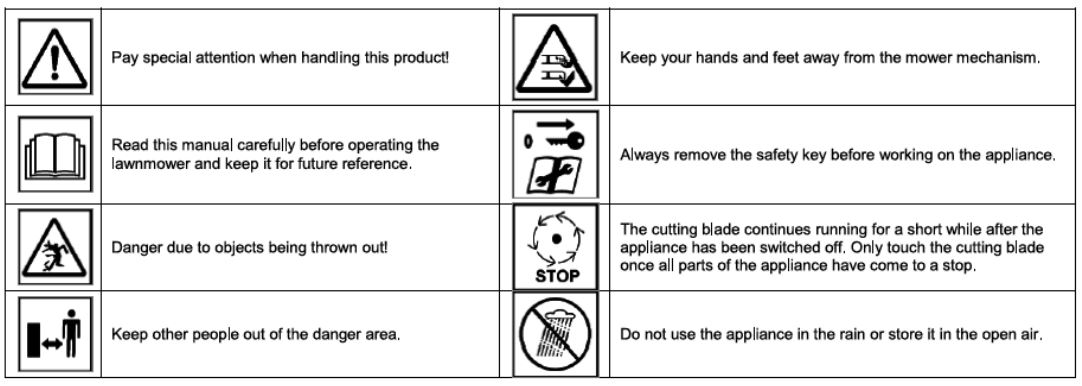
TECHNICAL SPECIFICATIONS

GENERAL POWER TOOL SAFETY WARNINGS:

Save all warnings and instructions for future reference.
The term “power tool” in the warnings refers to your mains-operated (corded) power tool or battery-operated (cordless) power tool.
1) Work area safety
- a) Keep work area clean and well lit. Cluttered or dark areas invite accidents.
- b) Do not operate power tools in explosive atmospheres, such as in the presence of flammable liquids, gases or dust. Power tools create sparks which may ignite the dust or fumes.
- c) Keep children and bystanders away while operating a power tool. Distractions can cause you to lose control.
2) Electrical safety
- a) Power tool plugs must match the outlet. Never modify the plug in any way. Do not use any adapter plugs with earthed (grounded) power tools. Unmodified plugs and matching outlets will reduce risk of electric shock.
- b) Avoid body contact with earthed or grounded surfaces, such as pipes, radiators, ranges and refrigerators. There is an increased risk of electric shock if your body is earthed or grounded.
- c) Do not expose power tools to rain or wet conditions. Water entering a power tool will increase the risk of electric shock.
- d) Do not abuse the cord. Never use the cord for carrying, pulling or unplugging the power tool. Keep cord away from heat, oil, sharp edges or moving parts. Damaged or entangled cords increase the risk of electric shock.
- e) When operating a power tool outdoors, use an extension cord suitable for outdoor use. Use of a cord suitable for outdoor use reduces the risk of electric shock.
- f) If operating a power tool in a damp location is unavoidable, use a residual current device (RCD) protected supply. Use of an RCD reduces the risk of electric shock.
3) Personal safety
- a) Stay alert, watch what you are doing and use common sense when operating a power tool. Do not use a power tool while you are tired or under the influence of drugs, alcohol or medication. A moment of inattention while operating power tools may result in serious personal injury.
- b) Use personal protective equipment. Always wear eye protection. Protective equipment such as dust mask, non-skid safety shoes, hard hat, or hearing protection used for appropriate conditions will reduce personal injuries.
- c) Prevent unintentional starting. Ensure the switch Is in the off-position before connecting to power source and/or battery pack, picking up or carrying the tool. Carrying power tools with your finger on the switch or energising power tools that have the switch on invites accidents.
- d) Remove any adjusting key or wrench before turning the power tool on. A wrench or a key left attached to a rotating part of the power tool may result in personal injury.
- e) Do not overreach. Keep proper footing and balance at all times. This enables better control of the power tool in unexpected situations.
- f) Dress properly. Do not wear loose clothing or jewellery. Keep your hair, clothing and gloves away from moving parts. Loose clothes, jewellery or long hair can be caught in moving parts.
- g) If devices are provided for the connection of dust extraction and collection facilities, ensure these are connected and properly used. Use of dust collection can reduce dust-related hazards.
4) Power tool use and care
- a) Do not force the power tool. Use the correct power tool for your application. The correct power tool will do the job better and safer at the rate for which it was designed.
- b) Do not use the power tool if the switch does not turn it on and off. Any power tool that cannot be controlled with the switch is dangerous and must be repaired.
- c) Disconnect the plug from the power source before making any adjustments, changing accessories, or storing power tools. Such preventive safety measures reduce the risk of starting the power tool accidentally.
- d) Store idle power tools out of the reach of children and do not allow persons unfamiliar with the power tool or these instructions to operate the power tool. Power tools are dangerous in the hands of untrained users.
- e) Maintain power tools. Check for misalignment or binding of moving parts, breakage of parts and any other condition that may affect the power tools operation. If damaged, have the power tool repaired before use. Many accidents are caused by poorly maintained power tools.
- f) Keep cutting tools sharp and clean. Properly maintained cutting tools with sharp cutting edges are Jess likely to bind and are easier to control.
- g) Use the power tool, accessories and tool bits etc., in accordance with these instructions and in the manner intended for the particular type of power tool, taking into account the working conditions and the work to be performed. Use of the power tool for operations different from intended could result in a hazardous situation.
5) Service

It is recommended that this tool is always supplied via a residual current device with a rated current of 30mA or less.
SPECIFIC ELECTRIC LAWN MOWER SAFETY INSTRUCTIONS
(note that some may not apply to this model of lawnmower)
- Never allow children, or people who do not know the instructions for use, to use the lawnmower.
- Disconnect the power cord before performing any inspection, maintenance, or repair work.
- In the working area of the lawnmower, the user is responsible for damages to third parties caused by the use of the lawnmower.
- Only work in good lighting conditions or provide appropriate artificial lighting.
- Always check the lawnmower for any signs of damage.
- Make sure that all protective devices are installed and working properly.
- Never use the lawnmower when you are tired.
- Never use the lawnmower in a closed or poorly ventilated area, or in the presence of flammable explosive liquids, vapours or gases.
- Shut off the motor and unplug the power cord before removing any blockages or obstructions in the chute and before you check the mower, clean it, work on it, and if a
foreign object has been hit. - Before use, always check visually whether the cutting tools, mounting bolts and the entire cutting unit are worn or damaged. To avoid an imbalance, worn or damaged cutting tools and fastening bolts may only be exchanged in sets.
- Damaged parts of the lawnmower must be replaced by a specialist. Only original spare parts may be used.
- When assembling or disassembling the knife, follow the instructions and wear protective gloves.
- Check the terrain on which the lawn mower is installed and remove any objects that may be caught and thrown out. Foreign objects must be removed before mowing. Pay
attention to extension cables, which you need for operation. - Always wear sturdy, non-slip footwear and long trousers during mowing. Never mow barefoot or with light sandals.
- Always use the lawnmower with the catcher, or work with the protective flap closed, when the catcher is not being used.
- Do not lift the lawnmower when starting the engine.
- Never put hands or feet on or under rotating parts. Always stay away from the discharge opening.
- Before you disconnect or empty the grass bag, the engine must be switched off and the blade must be stopped.
- When mowing on slopes, always mow across the slope.
- Do not mow directly up or down slopes over 15%.
- Before lifting the lawnmower for transport, switch off the engine and disconnect the power cord and wait for the blade to stop.
- Make sure that during operation no persons, especially children and animals, are in the immediate vicinity of the lawn mower. Make sure that a safety distance of 10 meters is maintained.
- Store the lawnmower in a dry place that is inaccessible to children.
- When starting the motor, do not tilt the mower unless the lawnmower needs to be raised during the process. In this case, tilt it only as far as is absolutely necessary and only lift up the side away from the user.
- If the lawnmower starts to vibrate abnormally, an immediate check is required. Immediately unplug the power cord if the lawnmower begins to vibrate abnormally.
- Make sure that all nuts, bolts, and screws are tightened, and the unit is in a safe working condition before use.
- If a foreign object has been hit, look for damage to the lawnmower and make the necessary repairs before starting again and working with the lawnmower.
- The lawnmower must not be exposed to rain. The lawn must not be wet or very moist.
- Always be sure to stand securely while working.
- Run the machine only at walking pace.
- Be especially careful when changing the direction of travel on a slope.
- Be especially careful when reversing the mower or pulling it towards you.
- Stop the blade when lifting the lawnmower over areas other than grass when moving the lawnmower from and to the mowing surface.
- Start or operate the starter switch with care in accordance with the manufacturer’s instructions. Make sure there is sufficient distance between the feet and the cutting tool.
Do not start the engine when standing in front of the discharge chute. - Do not touch the cutting blade before the machine is disconnected from the mains and the cutting blades have come to a complete stop.
- Never lift or carry the lawnmower with the engine running.
- Stop the engine when leaving the lawnmower and unplug the power plug.
- Allow the lawnmower to cool before placing the machine indoors.
- Regularly check the catcher bag for signs of wear or loss of functionality.
- Before adjusting or cleaning the mower, or before checking that the power cord is tangled or damaged, switch off the mower and disconnect the power plug.
MAKO ELECTRIC LAWN MOWER OPERATING INSTRUCTIONS
ASSEMBLY AND ADJUSTMENTS
WARNING! The Lawnmower must not be used or switched on until ii has been fully assembled.
Assembly – The Mako Lawnmower is mostly assembled when shipped. The handles do need to be assembled and fitted to the body by the user, and the power cable clipped to them, when received, however.
Attach the two lower handles to the mower body, using the plastic knobs provided.
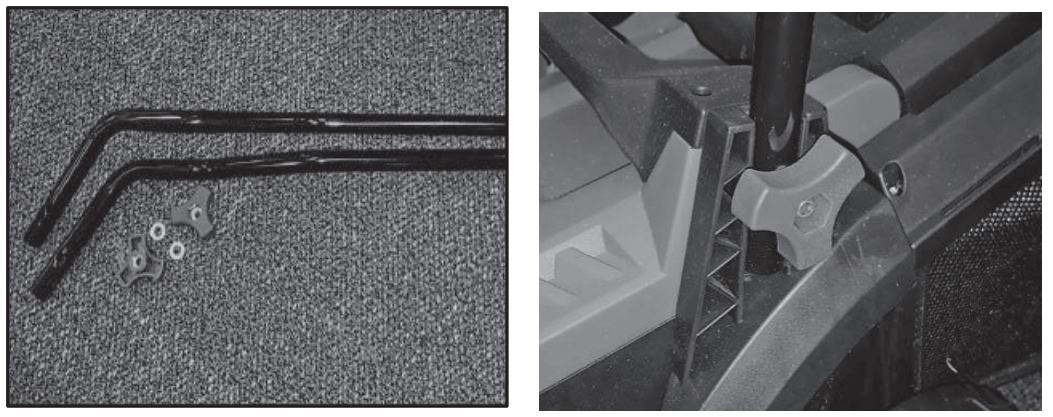
Attach the top section of the handle to the lower tubes using the bolts, washers and plastic knobs provided. (Ensure the cable retainer loop is fitted below the handle sheathing.) The top section of the handle with the switch should be pointing directly up. Clip the electric cable to the right-hand handle lube using the plastic clips.
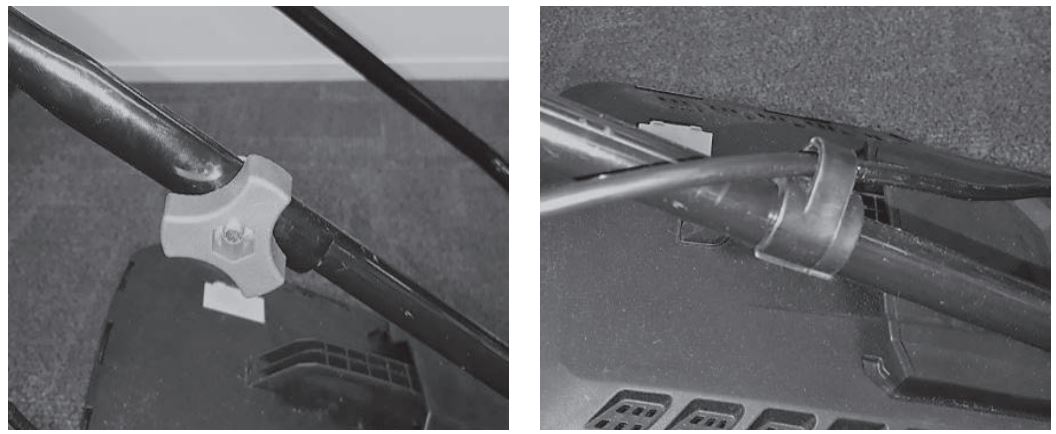
Unfold the fabric catcher and fit to the rear of the mower after lifting the rear cover. Lower the rear cover and ensure that it is located into the groove in the top cover of the catcher in order to hold the catcher in place.

Setting the cutting height –
Adjust the mowing height only when the mower is turned off, the power plug removed, and the blade is no longer rotating.
The mowing height is adjusted using the grey handle on the right side of the mower.
Pull away slightly from the mower to disengage, and lift up or down, then allow to spring back to engage the height notches.
Ensure the lever if fully engaged before using the mower.
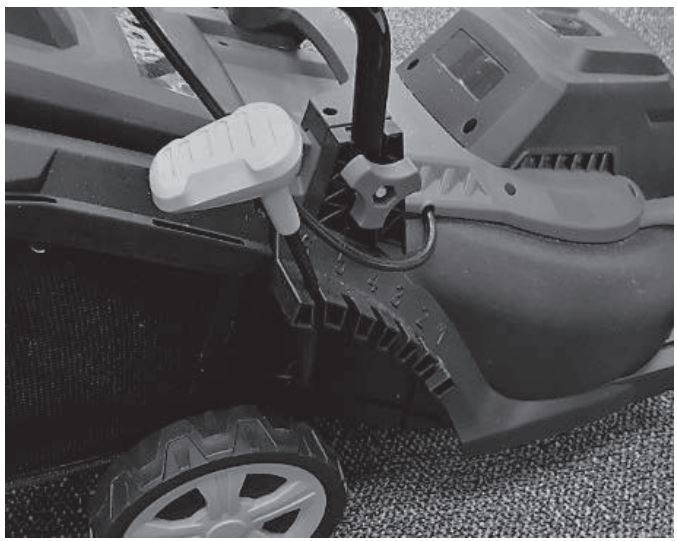
Operating the Mower
The mower must be plugged into a RCD-protected outlet that is installed indoors, or is a proper outdoor-approved weather resistant outlet.
It is recommended that this tool is always supplied via a residual current device with a rated current of 30mA or less.
Use only extension cords that are intended for outdoor use and are so marked.
Always unwind any extension cords fully.
For extension cords up to 15 meters use a wire cross section of 1.5mm2.
For extension cords over 15 meters but less than 40 meters use a wire cross section of 2.5mm2.
Always replace a damaged extension cord before using it.
Protect your extension cord from sharp objects, excessive heat and damp or wet locations.
Place the extension cord.in front of the mains socket and mow away from the outlet, so that the cord extends over cut grass. This will help prevent running it over when mowing.
Attention!
In order to prevent unintentional switching on, the lawn mower is equipped with a Switch-on Lock-out button A which must be pressed before the red Switch Levers B on the On/Off Controller can be pressed. When the switch levers are released, the lawnmower is switched off and can’t be re-started until that lock-out button is pressed again. Operate this a few times to make sure your device is working properly.
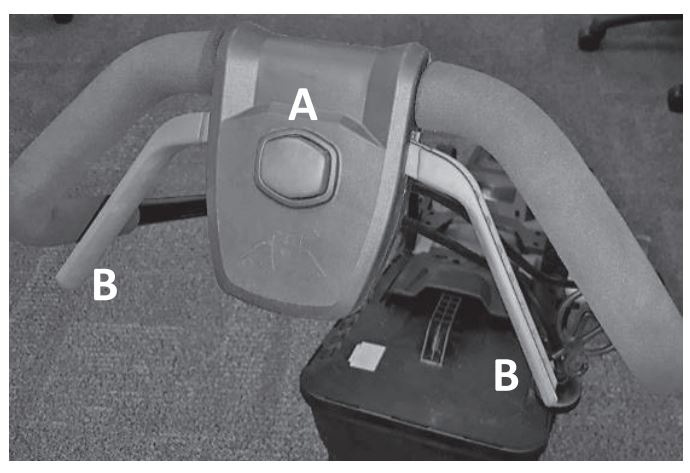
Danger!
Never open the rear cover/discharge chute cover or remove the catcher when the engine is still running. The rotating blade can cause injury.
Always attach the catcher carefully and ensure ii is secure before using. When removing, tum off the engine first.
When mowing and changing direction on slopes, special care is required. Ensure a secure footing, wear shoes with non-slip, non-slip soles and long trousers. Always mow across the slope. Slopes over 15 degrees should not be mowed with the lawn mower, for safety reasons.
Exercise extra care when moving backwards and pulling the lawnmower. Stumble danger!
For correct mowing:
When mowing, overlapping of the mower path by a few centimetres is recommended to ensure full coverage. Cut only with a sharp, undamaged blade, so that the grass blades do not tear and the lawn does not turn yellow. Guide the lawnmower in straight lines as far as possible for a clean look.
Keep the bottom of the mower deck clean and remove grass deposits. Deposits make it harder to start, affect the quality of cut and the grass ejection.
Choose the cutting height, depending on the actual turf length. Perform several passes so that a maximum of 4cm of grass is removed at once.
Before performing any checks on the blade, or before cleaning out the underside of the mower or discharge chute you must switch off the mower, and remove the plug from the mains outlet. Remember that the knife continues to rotate for a few seconds after the motor is turned off. Never try to stop the blade.
Check regularly that the blade is properly secured, in good condition and well sharpened. If not, re-sharpen or replace.
If the moving blade strikes an object, stop the lawnmower and wait until the blade stops completely. Then check the condition of the blade and mounting. If they are damaged they must be replaced immediately.
If grass is not being cut when passed over by the mower, empty the catcher – it is probably over full.
Danger! Stop the motor and wait for the blade to stop before removing the catcher. To remove the grass catcher lift the rear cover with one hand, and with the other hand grasp the handle and lift out the catcher.
In accordance with the safety regulations, the rear cover flap falls when the catcher is released and closes the rear ejection opening.
If grass clogs the opening, it is advisable to pull back the mower by about 1m for easier starting of the motor.
Cut grass in the mower housing and on the blade should not be removed by hand or with the feet, but with suitable tools, eg. brush or hand brush.
To ensure effective collection, the bag, and especially the air outlet grid must be cleaned from the inside after use.
Only fit the catcher with the motor switched off and the blade stopped. Lift the rear cover with one hand and with the other hand hold the catcher handle and hook in from above.
Allow the rear cover to close back onto the catcher. Check it is secure before using.
MAINTENANCE AND CLEANING

Checking and renewing the cutting blade:
WARNING! Severe injuries due to blade parts being flung out!
A worn, cracked, or damaged cutting blade can break, and its parts can become dangerous projectiles. ·Regularly check the cutting blade for damage.
Do not use the lawnmower if the cutting blade is worn or damaged.
Only have blunt or damaged cutting blades sharpened or replaced by an authorized specialist.
To avoid vibrations, the cutting blade and blade bolt must always be replaced together.
Rehappened cutting blades must be balanced. Unbalanced cutting blades cause strong vibrations and will damage the mower.
Maintenance
There are no further serviceable parts inside the lawnmower.
Other maintenance is limited to cleaning the catcher and mower surfaces of dust and debris.
Use a stiff brush to clean both. Avoid using compressed air or blowers due to potential for flying debris and dust inhalation.
DISPOSAL:
![]() Do not dispose of electrical appliances with your domestic wastrel Recycle where facilities exist. Contact your local council for advice.
Do not dispose of electrical appliances with your domestic wastrel Recycle where facilities exist. Contact your local council for advice.
The packaging comprises exclusively environmentally-friendly material. Dispose of it in your local recycling containers.
Made in China
Marketed by:
The Warehouse Limited
P.O. Box 33470, Takapuna, Auckland, New Zealand.
0800 422 274
